|
|
|
| My Favourite Planet > English > Middle East > Turkey > Pergamon > gallery 2 |
| Pergamon gallery 2 |
Pergamon art |
 |
 |
19 of 26 |
 |
 |
|
| |
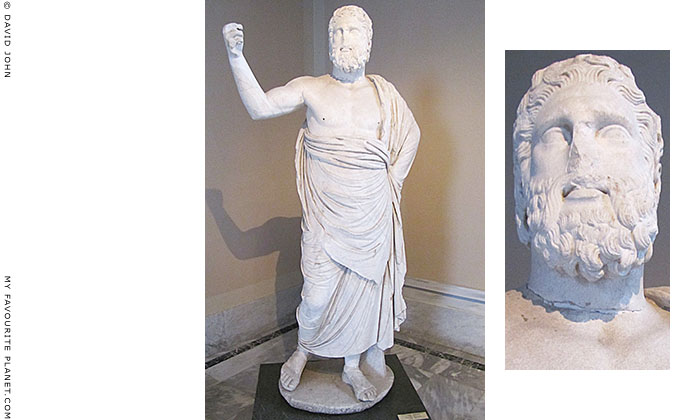
Statue of a bearded god, so-called "Zeus Ammon", from Pergamon.
Istanbul Archaeological Museum. |
| |
Discovered in early 1879 at the north side of the Great Altar of Zeus, this 215 cm high marble statue is dated to 150-130 BC, and is thought to be a copy of a 4th century BC original [1]. It was at first identified by archaeologists as Zeus Ammon, a combination of the great father gods of ancient Greece and Egypt. The identification was partly due to the small horns on the top of the figure's head which were associated with the goat-headed Ammon. However, it was later thought more likely to represent either Dionysos Tauros or Sabazios (Σαβάζιος), a companion of the mother goddess Kybele (Κυβέλη). A statue of Kybele, also in Istanbul Archaeological Museum, was found together with this statue [2].
Still the name Zeus Ammon persists, and the statue in the Istanbul Archaeological Museum is labelled "Statue of the supreme god Zeus Amon, god of the sky". It is one of many similar statues and heads of bearded gods in museums and collections around the world (for example, see the photo of the statue of Poseidon in the Pergamon Museum Berlin, on gallery 2, page 18). Many can not identified beyond doubt, often because their identifying symbols or attributes are missing.
The head, body and pose of this figure strongly suggest either the father god Zeus, who is typically shown holding a thunderbolt or staff; or his brother, the sea god Poseidon, who traditionally carried a trident. In the Hellenistic period Zeus Ammon was often depicted wearing ram's horns on his head (see the depiction of Alexander the Great as Zeus Ammon in the photo, right).
As for the suggestion that this could be Dionysos, this would be a very untypical depiction of the god of wine and revelry for the 4th century BC (See some images of Dionysos in Pella gallery page 9). Like Zeus, Dionysos is often shown holding a staff, his pine-cone topped "thyrsos", but not in such a grandiose pose, which was usually reserved for Zeus and Poseidon. The objection concerning the haughty pose could also apply to Tauros and Sabazios.
During the division of archaeological finds between Prussia and Turkey in 1879, this statue was taken to Berlin. In 1885 it was sent to Istanbul in exchange for a newly-found block of the frieze from the Zeus Altar. The Pergamon Museum has a plaster cast of the statue [3] which it first displayed in public during the temporary exhibition "Pergamon: Panorama of the Ancient City" in 2012. |
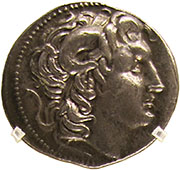
Silver tetradrachm of Lysimachos of Thrace.
The earliest known
depiction of Alexander
the Great wearing ram's
horns, the symbol of Zeus
Ammon. 305-281 BC.
Numismatic Museum,
Athens. |
| |
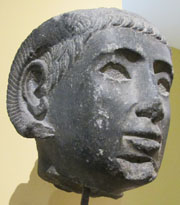
Diorite head of a Ptolemaic
king (Ptolemy I?) as Zeus Ammon.
From Egypt, 332-330 BC.
Museum of the Ancient Orient, Istanbul Archaeological Museums.
Inv. No. 10379. |
| |
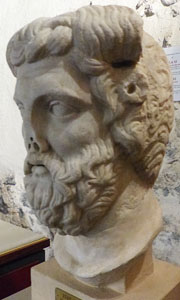
Head of Zeus Ammon.
Roman copy of a model of the 4th century BC. The ends of the ram's horns on each side of the top of the head are now missing.
Museo Civico Castello Ursino, Catania, Sicily. Biscari Collection. |
| |
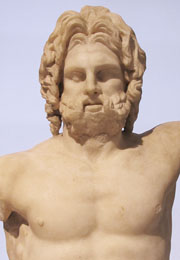
The "Enthroned Zeus" statue from the terrace of the Great Altar of Zeus, Pergamon. Marble, 100-80 BC. Another statue of a bearded male deity, who could be Poseidon, Asklepios or Pluto. [4]
Pergamon Museum, Berlin. |
| |
| |
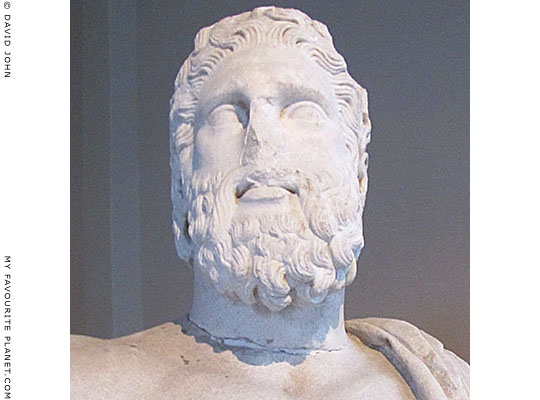
Zeus Ammon? |
| |
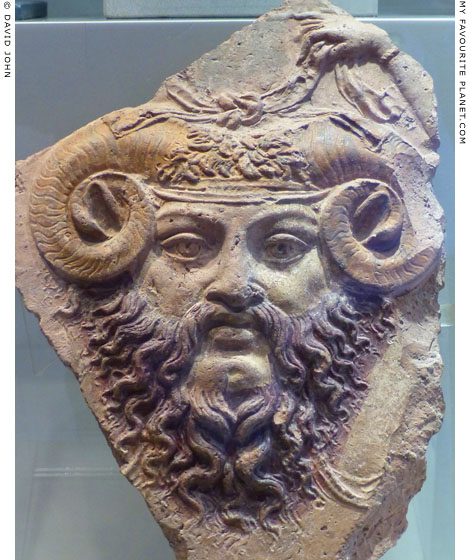
Fragmentary ceramic slab with a relief of Jupiter Ammon.
Polychrome terracotta. 1st century AD.
Barracco Museum, Rome. Inv. No. MB 199. |
| |
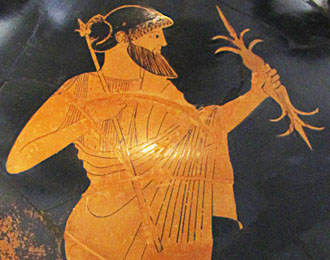
Detail of an Attic red-figure amphora showing
Zeus holding thunderbolts, formed by two lotus
blossoms, in his left hand.
480-460 BC. Found in Locri, Italy.
Pergamon Museum, Berlin. |
|
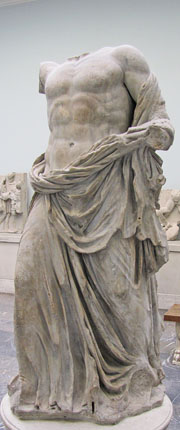
Marble statue of Zeus from
the Great Altar of Zeus,
Pergamon. 2nd century BC.
Pergamon Museum, Berlin. |
|
| |
Pergamon
gallery 2 |
Notes, references and links |
 |
|
1. The "Zeus Ammon" statue from Pergamon in Istanbul
Istanbul Archaeological Museum. Inv. No. 359.
The statue stands on a plinth or socket 65 cm wide and 53 cm deep.
See:
Franz Winter, Altertümer von Pergamon, Band VII, Text I: Die Skulpturen, mit Aussnahme der Altarreliefs. Pages 60-62; Tafel X, Beiblatt 7. (The antiquities of Pergamon, Volume 7, Text 1: The sculptures, with the exception of the Altar reliefs.) Königliche Museen zu Berlin. Verlag von Georg Reimer, Berlin, 1908.
Gustave Mendel (1873-1938), Catalogue des sculptures grecques, romaines et byzantines, Tome Second, pages 371-373. Musée Impérial, Constantinople (Istanbul), 1914.
2. Statue of Kybele in Istanbul Archaeological Museum
This is according to exhibition documentation of the Pergamon Museum, Berlin. I do not recall seeing such a statue of Kybele from Pergamon in Istanbul, and have so far found no other references to it, although there are statuettes, reliefs and fragmentary statues in Berlin and the Bergama Archaeoligical Museum. The search continues ...
3. Plaster cast of the "Zeus Ammon" statue from Pergamon in Berlin
The plaster cast was publicly exhibited for the first time during the temporary exhibition "Pergamon: Panorama of the Ancient City", in the Pergamon Museum, Berlin in 2012. See photo, right.
Gipsformerei, Staatliche Museen zu Berlin (SMB), GF 2015.
4. The "Enthroned Zeus" statue from Pergamon in Berlin
"Thronender Zeus". Berlin, Antikensammlung SNB, AvP VII 185.
Only the head and upper torso of the statue of the sculpture have survived, as well as a bronze dowel which originally held the right arm to the shoulder. |
|
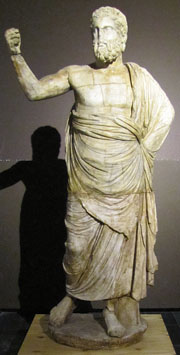
Plaster cast of the "Zeus
Ammon" statue, exhibited
in the Pergamon Museum,
2012. |
|
| |
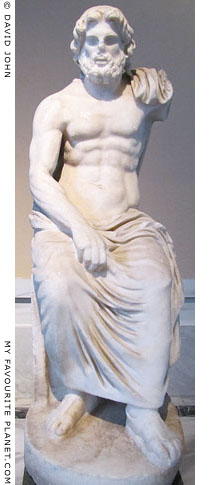
Marble statue of seated Zeus.
From Demirci, Çine, Aydin.
Hellenistic, 2nd-1st century BC.
Istanbul Archaeological Museum.
Inv. No. 1132 T. Cat. Mendel 535. |
|
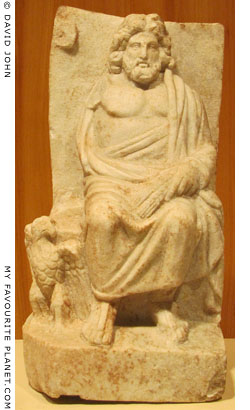
Marble statuette of enthroned Zeus
with his sacred eagle. From Nikomedia
(Izmit). Roman Imperial period,
2nd century AD.
Istanbul Archaeological Museum,
Inv. No. 5054 T. |
|
Maps, photos and articles: © David John,
except where otherwise specified.
Additional photos: © Konstanze Gundudis
All photos and articles are copyright protected.
Images and materials by other authors
have been attributed where applicable.
Please do not use these photos or articles without permission.
If you are interested in using any of the photos for your website,
project or publication, please get in contact.
Higher resolution versions are available on request. |
| |
 |
Visit the My Favourite Planet Group on Facebook.
Join the group, write a message or comment,
post photos and videos, start a discussion... |
|
|
| |
|
|
|